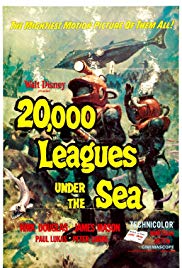This science fiction classic contains the story of Captain Nemo and the crew of the Nautilus which was an atomic submarine. This wouldn’t appear to be science fiction in our day and age. However, the story takes place in the second half of the 19th century. The film is based on the book written by Jules Verne, published in 1870.
Selected Awards: Academy Award for Special Effects, 1954.
Featured Actors: Kirk Douglas, James Mason, Paul Lukas, Peter Lorre, Robert J. Wilkie, Ted de Corsia.
Director: Richard Fleischer.
Written when submarines and atomic energy were only fantasies, this fast-paced adventure demonstrates how the future can be predicted by well-conceived science fiction.
MINOR. There are a number of fight scenes in the old style that do not involve gore but that are very energetic. There is some alcohol consumption and Ned Land gets drunk on occasion.
Explain to your children that the book on which this film was based was written in 1870, long before there were any real submarines, and long before scientists had any idea that there were atoms from which they could make atomic energy. Wonder with him or her about all the machines in this film that had never been imagined before. Ask and answer the Quick Discussion Question.
Jules Verne (1828 – 1905) is regarded as the father of science fiction. Writing in the second half of the nineteenth century, he combined knowledge of science with the ability to tell a good adventure story. He predicted many aspects of modern life such as space travel, submarines, helicopters, air conditioning, guided missiles, television, and motion pictures.
1. See Discussion Questions for Use With any Film that is a Work of Fiction.
2. There are several types of stories that people can tell. These are called genres. A few of them are: (1) normal fiction in which the story uses realistic settings and characters; the events of the story could happen to people in everyday life; (2) historical fiction in which the story is set in a specific time in the past and provides a fictional account of historical events or of important historical figures; (3) fantasy in which magic or supernatural characters form a primary element in plot or setting; and (4) science fiction in which real or imagined technology and scientific theories play an important role in setting and the events of the story; science fiction can contain large elements of fantasy such as alien creatures, imagined planets, or different dimensions. Pick a book you have read or a movie you have seen, name its genre and describe why you placed it in that genre.
Suggested Response:
Answers will vary. Note that classifications are flexible, and there will be few wrong answers. The key is to get students to think about the differences in various types of stories they read or see on the screen. For example, The Wizard of Oz is fantasy because the story contains magic and supernatural settings.
3. Think about what was happening in 1866, the year in which this story was set. What war had just ended? How did people get around on land and sea? Was there any air travel at the time? What did people wear?
Suggested Response:
Here are a few suggestions. The U.S. Civil War had just ended. There were no cars, and people got around using horses or buggies drawn by horses. There were trains, but they were steam and not diesel or electric. There were steam-powered boats, paddle wheels on the rivers. There were no electric lights, no telephones, no radios, no television, no computers, no radar, and no sonar. The telegraph had just recently been invented.
1. Assignments, Projects, and Activities for Use With any Film that is a Work of Fiction.
2. The class can be divided into groups with each group assigned to write a science fiction story, limiting the science fiction elements to two new inventions and working out how those inventions will lead to changes that affect the characters or the plot. This assignment can also be given to each student individually. For a more fully developed assignment to write a science fiction story for grades 6 – 8, see Lesson Plans Library.
3. Students can be asked to write the next chapter after “20,000 Leagues Under the Sea” ends.
Books by Jules Verne that are appropriate for junior high or middle school readers include Twenty Thousand Leagues Under the Sea; Journey to the Center of the Earth, From the Earth to the Moon, Mysterious Island, and Around the World in 80 Days. They are all excellent examples of early science fiction.
For general science fiction reading recommended for this age group, see the Learning Guide to Fahrenheit 451. For science fiction dealing with time travel, see the Learning Guide to The Time Machine.


